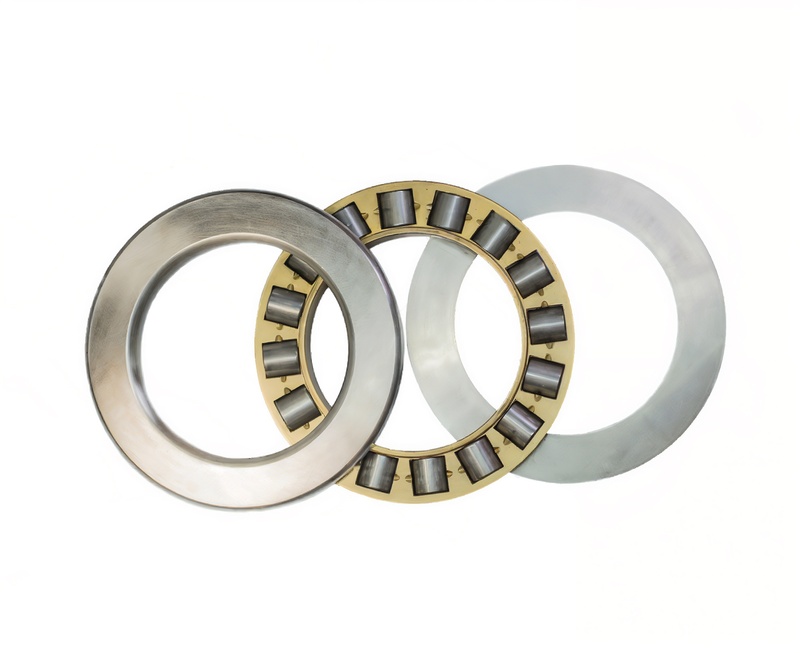Need Support?
Please provide your question. We’ll find you with the best support options.
ISK Bearings | B2B Bearing Wholesale
Quickly select what you need
Thrust bearings (axial bearings) are rotary components designed to support axial loads (forces parallel to the shaft), ensuring rotating parts are correctly positioned. Using balls or rollers, they provide stable, low-friction operation and are crucial in high-axial-force systems like automotive transmissions and pumps.
Thrust bearings—also referred to as axial bearings—are designed to support forces that act parallel to the shaft. Unlike radial bearings, which carry loads perpendicular to the shaft, thrust bearings handle axial loads and keep rotating components correctly positioned.
The primary function of a thrust bearing is to carry or control axial loads during rotation. They are used in mechanical systems where axial force is significant, such as automotive transmissions, clutches, fans, pumps, and compressors. By maintaining axial stability, thrust bearings help ensure smooth and reliable operation in these applications.
Thrust bearings typically consist of one or more axial balls or rollers housed within a bearing seat. Their design allows them to withstand high axial loads while maintaining low friction. A retainer is often present between the balls or rollers and the shaft to keep them properly positioned.
Thrust bearings come in two main types: unidirectional and bidirectional.
Choosing the right type depends on the load requirements and the specific needs of the application.
In summary, thrust bearings are designed to handle axial loads and provide stable operation with low friction. They play a critical role in many mechanical applications, ensuring the reliable operation of rotating equipment.
Thrust Ball Bearings and Thrust Roller Bearings are common types of thrust bearings used to withstand axial or thrust loads.
Thrust ball bearings rely on spherical balls as rolling elements and are designed for low-speed applications with small to medium axial loads. They have a compact structure, are easy to assemble, and are cost-effective. You’ll commonly find them in automotive transmissions, fans, and household appliances.
|
Thrust Ball Bearing Size Chart |
||||
|---|---|---|---|---|
|
Bearing No. (Flat type) |
Bore(d)(mm) |
Outer(D)(mm) |
T(mm) |
r(mm) |
| F9-19M | 9 | 19 | 6.5 | - |
| F9-20M | 9 | 20 | 7 | - |
| 51100 | 10 | 24 | 9 | 0.5 |
| 51200 | 10 | 26 | 11 | 1 |
| F10-18M | 10 | 18 | 5.5 | - |
| 51101 | 12 | 26 | 9 | 0.5 |
| 51201 | 12 | 28 | 11 | 1 |
| F12-23M | 12 | 23 | 7.5 | - |
| 51102 | 15 | 28 | 9 | 0.5 |
| 51202 | 15 | 32 | 12 | 1 |
| 51103 | 17 | 30 | 9 | 0.5 |
| 51203 | 17 | 35 | 12 | 1 |
| 51104 | 20 | 35 | 10 | 0.5 |
| 51204 | 20 | 40 | 14 | 1 |
| 51105 | 25 | 42 | 11 | 1 |
Thrust roller bearings use rollers as their rolling elements and come in different types based on roller shape. Thrust needle bearings feature long, thin needle rollers, while thrust cylindrical bearings use cylindrical rollers. Each type is designed to handle specific load and performance requirements.
|
Thrust Roller Bearing Size Chart |
|||||
|---|---|---|---|---|---|
|
Bearing No. |
Bearing No. (Thrust bearings plate) |
Bearing No. (Bearings plate) |
Dc1(mm) |
Dc(mm) |
DW(mm) |
| AXK 0414TN | AS 0414 | - | 4 | 14 | 2 |
| AXK 0515TN | AS 0515 | - | 5 | 15 | 2 |
| AXK 0619TN | AS 0619 | LS 0619 | 6 | 19 | 2 |
| AXK 0821TN | AS 0821 | LS 0821 | 8 | 21 | 2 |
| AXK 1024 | AS 1024 | LS 1024 | 10 | 24 | 2 |
| AXK 1226 | AS 1226 | LS 1226 | 12 | 26 | 2 |
| AXK 1528 | AS 1528 | LS 1528 | 15 | 28 | 2 |
| AXK 1730 | AS 1730 | LS 1730 | 17 | 30 | 2 |
| AXK 2035 | AS 2035 | LS 2035 | 20 | 35 | 2 |
| AXK 2542 | AS 2542 | LS 2542 | 25 | 42 | 2 |
| AXK 3047 | AS 3047 | LS 3047 | 30 | 47 | 2 |
| AXK 3552 | AS 3552 | LS 3552 | 35 | 52 | 2 |
| AXK 4060 | AS 4060 | LS 4060 | 40 | 60 | 3 |
| AXK 4565 | AS 4565 | LS 4565 | 45 | 65 | 3 |
| AXK 5070 | AS 5070 | LS 5070 | 50 | 70 | 3 |
Thrust needle bearings, with their smaller rolling diameters, are ideal for handling high axial loads in compact spaces. They are often found in automotive transmissions, drive shafts, and small mechanical devices. Thrust cylindrical bearings, featuring larger rollers, offer higher load capacities and are better suited for medium to large axial load applications, such as industrial equipment, metallurgical machinery, and machine tools.
While thrust roller bearings provide greater load capacity and rigidity compared to thrust ball bearings, they come with a more complex structure, making assembly and adjustments more challenging.
In summary, thrust ball bearings and thrust roller bearings are common types of thrust bearings. They are designed to withstand and support axial loads in various applications. Selecting the appropriate bearing requires considering factors such as load magnitude, speed requirements, space limitations, and structural complexity.
Cylindrical thrust roller bearings are designed to handle only axial loads, but they can support high-load applications and offer high axial rigidity. The cages are typically made of machined brass.

Characteristic:
Applications:
Rotary work tables for machine tools, powdering machine rotary tables.
The Comprehensive Guide to Needle Roller Bearings 
Tapered roller thrust bearings use small tapered rollers designed to meet at a single point on the bearing axis. This precise design ensures smooth rolling and prevents skidding. These bearings are commonly used in automotive applications, such as supporting wheels, and are often paired to handle axial thrust in both directions as well as radial loads. Thanks to their larger contact area, they can carry higher thrust loads than ball bearings, though their manufacturing process is more expensive.
Spherical roller thrust bearings use asymmetrical spherical rollers that roll along a spherical raceway in the washer. They’re designed to handle both radial and axial loads while compensating for shaft misalignment. Commonly used alongside radial spherical roller bearings, they stand out for having the highest load capacity among thrust bearings.
Bearing model numbers consist of three parts:
We previously helped an electromechanical equipment manufacturer in Asia resolve abnormal bearing noise issues. By optimizing the sealing structure and adjusting lubrication parameters, we significantly improved system stability and reduced maintenance costs.
Case reference: ISK BEARING Customer Cases
We offer a range of testing and technical services, including independent heat treatment, automated noise & vibration testing, clearance inspection, salt spray testing, and more — helping our clients improve product reliability and performance.
Resource overview: ISK Technical Resources
You can visit the ISK official FAQ section to explore answers related to bearing selection, product specifications, and more.
FAQ Section: ISK Bearings FAQ Center
Discover more about the features and applications of various bearings.
Click here to explore more articles and find the perfect bearing for your project.
Needle Bearings (Roller Bearings) are a type of bearing that performs exceptionally well at high speeds. Their rollers are precisely guided by specially shaped, high-rigidity cages with minimal dimensional error. Despite their small cross-section, needle bearings...
How Do Ball Bearings Work? Bearings are often small and unassuming components in a product, yet they are crucial for its proper functioning. Without bearings, many products would fail to operate effectively. But do you know how ball bearings...
Please provide your question. We’ll find you with the best support options.